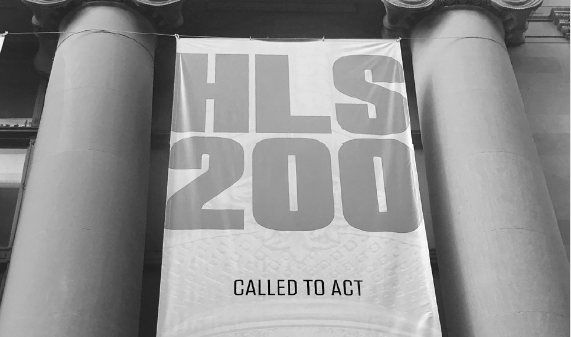The pressure on Harvard to divest from the prison-industrial complex is heating up and the debate is raging on campus. As organizers with the Harvard Prison Divestment Campaign, we caught wind of some misinformation circulating around campus about the campaign, the endowment, and divestment. We figured now was a perfect time to clear up this misinformation and do some mythbusting. So without further ado, here are your top five myths about prison divestment.
Myth #1: HPDC is only asking for divestment from private prisons.
The Facts: HPDC is demanding divestment from all companies that significantly profit off of the prison-industrial complex. The prison-industrial complex goes far beyond private prison operators like CoreCivic, GeoGroup, Sodexo, and G4S. But it also includes companies like Securus Technologies, which charges incarcerated folks 21 cents per minute for interstate calls and often over a $1 per minute for intrastate calls; the 3M Company, which uses prison labor in China to manufacture its packaging supplies; and Axon, which sells surveillance technology and weaponry to prisons. The prison-industrial complex also included financial services firm JP Morgan Chase & Co until recently. Under pressure from activist groups Make the Road New York & the Center for Popular Democracy, JP Morgan committed to stop funding private prison companies last week.
Myth #2: Harvard is contractually bound to the decisions of its external fund managers and legally cannot divest from prisons.
The Facts: This is an odd one. Proponents of this position never seem to provide evidence to substantiate this claim. Harvard Management Company is not generally in the business of disclosing the terms of its contract with its fund managers. As such, the terms are unknown to everyone beyond HMC and its fund managers. Unless proponents have some insider information, their position — which the HMC itself has never publicly taken — amounts to little more than speculation.
But in the spirit of debate, let’s entertain the hypothetical that Harvard is indeed contractually bound to the decisions of its external fund managers. Even if this were true in the short-term, Harvard maintains the largest university endowment in the world. And HMC has more than enough leverage to alter the terms of its contracts with external fund managers – if it sees fit. In the improbable event that external fund managers refuse to re-negotiate to allow divestment, it is even more improbable that they would pursue a legal claim against HMC. Any suit would necessarily jeopardise any future business with Harvard and any current business with other universities.
Myth #3: Disclosure is not necessary for divestment.
The Facts: The University’s lack of transparency on the true nature of their holdings remains an enormous obstacle to understanding the extent of its investments in the prison-industrial complex. Though the university discloses a portion of their holdings in publicly-traded stocks and funds through their SEC filings, these disclosures cover only $475 million of the total endowment. The rest of the endowment — some $38.7 billion — is managed through hedge funds, private equity firms, real estate investment firms, and other private entities. While we can learn the names of these private funds through the University’s past and future 990s disclosures, the precise nature of their activities is harder to ascertain.
Based solely on the SEC filings, we know that at least $2.25 million dollars are invested in companies that significantly profit from imprisonment like Bae Systems, Constellation Software, Geo Group, NEC Global, and Sturm Ruger & Co. But because the majority of the endowment remains in the dark, that number is likely a drop in the bucket. Without verified disclosure, University could decide to only partially divest and privately maintain its holdings in the prison industry.
Myth #4: Divestment would significantly damage the endowment’s profitability.
The Facts: In recent years, national media has covered how Harvard’s endowment returns have lagged behind its peers like Columbia, MIT, and Notre Dame. One might think that this vulnerable period would make divestment untenable in the short term.
But the evidence suggests otherwise. In 2015, Columbia became the first institute of higher education to divest from private prisons with University of California quickly following suit. In the three years following divestment, Columbia’s endowment posted an average annual return of 7.3%, while the UC systems posted 8.8% average annual return. In contrast, Harvard’s endowment posted an average annual return of 5.3% over the same period. This suggests that divestment does not significantly damage endowments’ profitability and that Harvard’s investments in prisons do not give it a significant competitive advantage.
Myth #5: Endowment investments are not political and shouldn’t be subject to political demands.
The Facts: You might have heard this whopper of a line making its way around campus recently. Most notably, University spokesperson Jonathan L. Swain stated to the Crimson that, “the University’s position, as it has stated previously, is that it should not use the endowment to achieve political ends, or particular policy ends.” But as recent coverage of the endowment demonstrates, Harvard’s current investments in the prison-industrial complex industry, in farmland in Brazil, and in water rights in California are having political consequences. As such, one might argue — quite plausibly — that the endowment is already being mobilized towards political ends, even if the University doesn’t intend it to.
But we don’t need to get into a philosophical debate over the nature of ‘the political’ or the line between economics and politics to expose the flaws in the university’s position. We only need to look at Harvard’s past actions. In 1989, the university divested from the tobacco industry; and in 2005 and 2006, Harvard divested from certain companies involved in oil production in Sudan. It was just and proper to “use the endowment to achieve political ends” then. Why not now?


